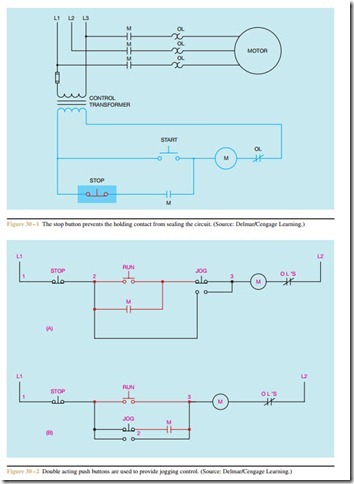The definition of jogging or inching as described by NEMA is “the quickly repeated closure of a circuit to start a motor from rest for the purpose of accomplish- ing small movements of the driven machine.” The term jogging actually means to start a motor with short jabs of power at full voltage. The term inching means to start a motor with short jabs of power at reduced volt- age. Although the two terms mean different things, they are often used interchangeably because both are accomplished by preventing the holding contacts from sealing the circuit.
Jogging Circuits
Various jogging circuits are presented in this chapter. As with many other types of control circuits, there are different ways in which jogging can be accomplished, but basically, jogging is accomplished by preventing the holding contact from sealing the circuit around the start push button when the motor starter energizes. It should also be noted that jogging circuits require special motor starters rated for jogging duty.
One of the simplest jogging circuits is shown in Figure 30 – 1. This circuit is basically a start-stop push- button control circuit that has been reconnected so that the START button is in parallel with both the STOP button and holding contact. To jog the motor, simply hold down the STOP button and jog the circuit by pressing the START button. To run the motor, release the STOP button and press the START button. If the motor is in operation, the STOP button will break the circuit to the holding contact and de-energize M coil.
Double Acting Push Buttons
Jogging can also be accomplished using a double acting push button. Two circuits of that type are shown in Figure 30 – 2. The normally closed section of the JOG push button is connected in such a manner that
when the button is pushed it will defeat the holding contact and prevent it from sealing the circuit. The normally open section of the JOG button completes a circuit to energize the coil of the motor starter. When the button is released, the normally open section breaks the circuit to M coil before the normally closed section reconnects to the circuit. This permits the starter to re- open the holding contacts before the normally closed section of the JOG button reconnects.
Although this circuit is sometimes used for jogging, it does have a severe problem. The action of either of these two circuits depends on the normally open M auxiliary contact (holding contact), which is used to seal the circuit, being open before the normally closed section of the JOG button makes connection. Since push buttons employ a spring to return the contacts to their normal position, if a person’s finger should slip off the JOG button, it is possible for the spring to re- establish connection with the normally closed contacts before the holding contact has time to reopen. This would cause the motor to continue running instead of stopping. In some cases, this could become a significant safety hazard.
Using a Control Relay
The addition of a control relay to the jog circuit eliminates the problem of the holding contacts making connection before the normally closed section of the jog push button reconnects. Two circuits that em- ploy a control relay to provide jogging are shown in Figure 30 – 3. In both of these circuits, the control relay, not M starter, provides the auxiliary holding contacts. The JOG push button energizes the coil of M motor starter but does not energize the coil of control relay CR. The START push button is used to energize the coil of CR relay. When energized, CR relay contacts provide connection to M coil. The use of control relays in a jogging circuit is very popular because of the simplicity and safety offered.
A jogging circuit for a forward-reverse control is shown in Figure 30 – 4. Note that a control relay is used to provide jogging in either direction. When the for- ward jog push button is pressed, the normally open section makes connection and provides power to F coil. This causes F load contacts to close and connect the motor to the power line. The normally open F auxiliary contact closes, also, but the normally closed section of the forward jog button is now open, preventing coil CR from being energized. Since CR contact remains open, the circuit to F coil cannot be sealed by the normally open F auxiliary contact.
If the forward start button is pressed, a circuit is completed to F coil, causing all F contacts to change position. The normally open F auxiliary contact closes and provides a path through the normally closed sec- tion of both jog buttons to CR coil. This causes CR auxiliary contact to close and provide a current path through the now closed F auxiliary contact to F coil, sealing the circuit when the forward push button is re- leased. The reverse jog button and reverse start button operate the same way. Note also that normally closed F and R auxiliary contacts are used to provide interlock- ing for the forward-reverse control.
Jogging Controlled by a Selector Switch
A selector switch can also be employed to provide jogging. The switch is used to break the connection to the holding contacts (Figure 30 – 5). In this circuit, a single-pole single-throw toggle switch is used. When the switch is in the ON position, connection is made to the holding contacts. If the switch is in the OFF position, the holding contacts cannot seal the circuit when the START button is released. Note that the START button acts as both the start and jog button for this circuit. A selector switch can be used to provide the same basic type of control (Figure 30 – 6).
